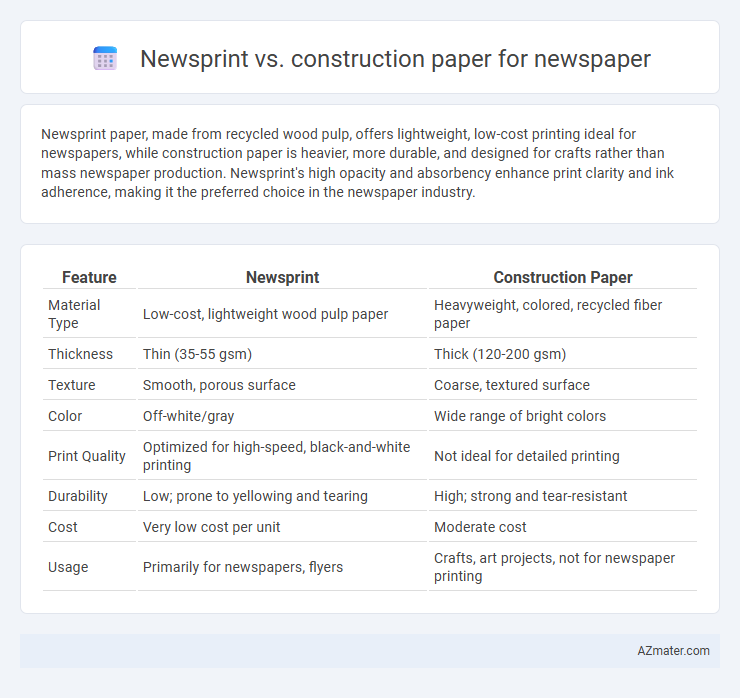Newsprint paper, made from recycled wood pulp, offers lightweight, low-cost printing ideal for newspapers, while construction paper is heavier, more durable, and designed for crafts rather than mass newspaper production. Newsprint's high opacity and absorbency enhance print clarity and ink adherence, making it the preferred choice in the newspaper industry.
Table of Comparison
| Feature | Newsprint | Construction Paper |
|---|---|---|
| Material Type | Low-cost, lightweight wood pulp paper | Heavyweight, colored, recycled fiber paper |
| Thickness | Thin (35-55 gsm) | Thick (120-200 gsm) |
| Texture | Smooth, porous surface | Coarse, textured surface |
| Color | Off-white/gray | Wide range of bright colors |
| Print Quality | Optimized for high-speed, black-and-white printing | Not ideal for detailed printing |
| Durability | Low; prone to yellowing and tearing | High; strong and tear-resistant |
| Cost | Very low cost per unit | Moderate cost |
| Usage | Primarily for newspapers, flyers | Crafts, art projects, not for newspaper printing |
Introduction: Choosing the Right Paper for Newspapers
Newsprint is a lightweight, low-cost paper designed specifically for printing newspapers, offering high opacity and fast ink absorption ideal for mass production. Construction paper, however, is thicker, rougher, and primarily used for crafts, lacking the smooth surface and absorbency required for clear newspaper printing. Selecting newsprint ensures sharp text, cost efficiency, and optimal performance for daily newspaper circulation.
Understanding Newsprint: Features and Composition
Newsprint is a lightweight, inexpensive material primarily made from wood pulp with high cellulose content, designed for efficient ink absorption and fast drying in newspaper printing. Its low brightness and smooth surface optimize legibility while maintaining cost-effectiveness, distinguishing it from thicker, more textured construction paper, which lacks the necessary print quality and durability for mass newspaper production. Newsprint's recycled fiber content and thin, porous structure enable high-speed presses to deliver sharp images and text without smudging or excessive ink bleed.
Construction Paper: Properties and Common Uses
Construction paper features a coarse texture and high porosity, making it less suitable for newspaper printing compared to smooth, lightweight newsprint paper. Its vibrant colors and durability are ideal for arts and crafts, educational projects, and decorative purposes rather than mass newspaper production. The heavier weight and rough surface of construction paper absorb ink unevenly, limiting its use to creative applications instead of traditional newsprint functions.
Cost Comparison: Newsprint vs Construction Paper
Newsprint is significantly more cost-effective than construction paper, making it the preferred choice for large-scale newspaper production due to its low price per sheet and bulk availability. Construction paper, while thicker and more durable, carries a higher cost that is unsuitable for mass printing. The affordability of newsprint helps publishers minimize expenses without compromising the volume required for daily circulation.
Print Quality: Ink Absorption and Image Clarity
Newsprint offers moderate ink absorption, which leads to slightly blurred images but is ideal for mass newspaper production due to its low cost. Construction paper has higher ink absorption, resulting in more vibrant colors but can cause ink bleeding, making it less suitable for detailed newspaper print. Newspapers prioritize print quality on newsprint to balance image clarity and production efficiency.
Durability and Handling: Which Paper Lasts Longer?
Newsprint, commonly used for newspapers, is lightweight and inexpensive but prone to yellowing and tearing over time, indicating limited durability. Construction paper is thicker and sturdier, offering enhanced resistance to wear and better handling during crafting, but its cost and texture are less suitable for mass newspaper printing. For longevity and frequent handling, construction paper outlasts newsprint, though newsprint remains the industry standard for disposable or short-term use newspapers.
Environmental Impact: Sustainability Considerations
Newsprint, made primarily from recycled fibers and requiring less bleaching, typically has a lower environmental footprint compared to construction paper, which often uses virgin fibers and heavy dyes that complicate recycling. The biodegradability of newsprint enhances its sustainability, whereas construction paper's synthetic pigments and coatings can hinder decomposition and increase landfill persistence. Choosing newsprint for newspapers supports waste reduction and resource efficiency, aligning with sustainable publishing practices.
Reader Experience: Texture and Visual Appeal
Newsprint offers a lightweight, coarse texture that enhances traditional newspaper reading with its matte finish, aiding in easy ink absorption and reducing glare for comfortable eye strain over extended periods. Construction paper features a thicker, fibrous texture and vibrant colors, which can add visual appeal but may detract from clarity and legibility, making it less suitable for standard newspaper printing. Readers seeking an authentic, clear, and easy-to-read newspaper experience benefit more from newsprint's smooth, consistent surface and subtle visual presentation.
Industry Preferences: Why Newspapers Choose Newsprint
Newsprint remains the preferred choice for newspapers due to its cost-effectiveness and lightweight properties, enabling efficient mass production and distribution. Its capacity for high-speed printing with clear image reproduction aligns with industry demands for quick turnaround and quality. Construction paper, being thicker and more textured, lacks the practicality and economic advantages necessary for large-scale newspaper printing.
Final Verdict: Best Paper for Newspaper Production
Newsprint remains the best paper for newspaper production due to its cost-effectiveness, lightweight nature, and high absorbency, which allows for clear ink reproduction and quick drying. Construction paper's heavier weight and rough texture make it unsuitable for high-speed printing presses and large-scale newspaper runs. The final verdict favors newsprint as the optimal choice for economical and efficient newspaper printing.

Infographic: Newsprint vs Construction paper for Newspaper
 azmater.com
azmater.com